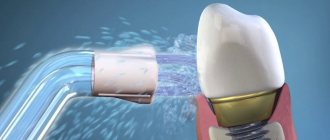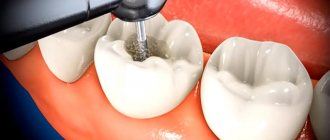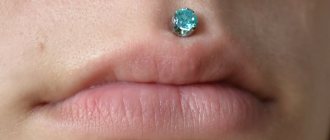In modern dentistry, when treating caries at different stages, doctors often install light fillings. This is explained by the advantages of photopolymer composite material compared to the traditional composition. The light filling looks natural (often the color does not differ from tooth enamel), is resistant to stress, and less toxic. In addition, its installation is easy and does not take much time.
To maintain the results obtained by the dentist, you must follow several recommendations. And then the material will not peel off and collapse.
Many patients are interested in the question of how long they should not eat or drink after the doctor fills a tooth with composite material. And in general, are there any restrictions? Now we will tell you everything in detail.
How much can you not eat after having a filling installed?
All patients are interested in whether they can eat after having a filling installed.
You can eat food, but not immediately after the event, but after some time. Experts use various compositions, and each of them has its own hardening time. But first, you need to consider what you can’t eat after installing a filling in order to avoid its premature destruction.
The list of prohibited products includes all solid products, including chips and crackers, viscous - toffee and other products of similar consistency, coloring - coffee and tea, tomatoes, beets and the like. The consumption of hard and viscous products contributes to the destruction of the filling, and the use of coloring products causes a change in the color of the filling material.
Temporary restrictions
The first question that patients ask the doctor after treatment is: how long can you not eat? It all depends on the technology used, and some of them allow you to eat food almost immediately.
But there is one caveat. Even if the top layer has already hardened, the inner layer is subject to deformation. Therefore, there is no need to rush. There are the following general recommendations on time limits (according to the type of material):
- amalgam – 3 hours;
- plastic – from 3 to 5 hours;
- cement - from 2 to 3 hours;
- photocurable composites – can be eaten immediately;
- chemically cured composites – 1 hour;
- temporary fillings except photopolymer ones – from 2 to 3 hours;
- photopolymer temporary fillings – no restrictions.
Using metal as a filling material
Fillings made of metal alloys have high levels of strength and durability; they are made from hypoallergenic materials. In modern dentistry, two types of metal filling material are popular:
- Gold.
- Silver or copper amalgam.
Gold fillings
Gold inlays are the most expensive solution. Their main qualities are strength, durability, and high aesthetic properties. Due to the ability of gold to resist corrosive processes, a filled tooth is not subject to destruction. The precious metal that forms the basis of the filling material determines its high cost. Installing a gold filling is a delicate and responsible job that requires great skill and skill from the doctor.
Is it possible to drink after having a filling installed?
At the appointment, patients always ask whether they can drink tea or other drinks after treatment. In this case, the same recommendations apply as for eating - it all depends on the technology. But there are also additional restrictions. Drinking drinks is not recommended until the anesthesia effect has completely subsided.
This is due to the possibility of injury to the mucous membrane by too hot a liquid, because sensitivity is reduced. It is very difficult to say exactly how long you can drink. In this case, everything depends on the effectiveness of the painkiller, its duration of action, dosage and individual reaction of the body.
Types of fillings and care features
Different fillings have their own characteristics in terms of wearing time, hardening, etc. For example, light fillings harden under the influence of a halogen lamp in a matter of seconds, so you can eat or drink water almost immediately after the procedure. However, you should not remove all restrictions: complete hardening of the filling occurs in two days. Composite fillings are very sensitive to alcohol at first, so you should avoid alcohol and alcohol-containing rinses, as the filling may soften.
After treatment, we recommend that you check with your dentist about the type of filling he placed and after what time you can eat.
Recommendations
Immediately after installation, you must refrain from drinking and eating for the time recommended by the dentist until the final effect of the pain medication. After this period, you should not eat foods that are too hot or too cold, as they may affect the strength properties of the material.
The load should be moderate. It is advisable to try not to chew on this side of the jaw during the day, since the filling may become loose if it does not harden sufficiently.
In addition to traditional questions about food and drink, dental visitors are also interested in additional questions.
Is it possible to drink alcohol
In fact, alcohol does not have any special effect, which means that theoretically it can be consumed. But the point here is completely different. In most cases, filling is performed under anesthesia, and it and alcohol are incompatible. Therefore, experts recommend abstaining from alcohol for at least a day.
The same can be answered to the question “can I drink beer?” After 24 hours, yes, you can. Beer does not contain coloring enzymes and fillings do not change color under its influence.
Is it possible to smoke after installation?
After the filling procedure, you can smoke approximately 2-3 hours later.
. Tobacco smoke does not affect the color of the filling, unless it concerns plastic-based compounds. They are rarely used due to their fragility, but when using such a composition, smoking immediately after the procedure will cause its darkening. Ideally, dentists recommend giving up cigarettes for at least a day, if possible.
Amalgam filling
Amalgam is an alloy of silver or copper with various metals, each of which performs its own function:
- Silver gives strength and antiseptic properties.
- Tin regulates the hardening process.
- Copper increases the strength of the alloy.
- Zinc prevents oxidation.
- Mercury is needed to obtain a plastic, quickly hardening mixture.
Amalgam fillings have both advantages and disadvantages. They are durable and affordable, but have low aesthetic properties (characteristic metallic luster, change in enamel color). These fillings are placed primarily on the back teeth (molars).
Metal fillings have a long hardening period, so dentists recommend that patients refrain from eating for 4-5 hours after the filling procedure. Do not consume foods that can cause metal oxidation. Since the dental alloy is insensitive to moisture, there are no restrictions on fluid intake.
What not to do after installation
The main thing that should not be done after installation is to subject the tooth to increased loads.
. Therefore, gnawing any foods (nuts, seeds, candies, etc.) is highly discouraged. Avoid the use of chewing gum, toffees and other similar confectionery products that tend to stick to teeth.
The consumption of hot and cold foods is limited; this can cause the filling material to break prematurely.
There should be no traumatic impact on the tooth, therefore, if discomfort is felt, you should consult a doctor and not take any action yourself.
Is it possible to brush your teeth
A specialist will definitely advise you on how to brush your teeth after installing a filling. It is advisable to do this only the next day. In some cases, it is recommended to change the paste and brush. It is better to choose a brush of medium softness; it will not injure the injection site. Pastes - on the recommendation of a doctor, but without the inclusion of abrasive components.
Recommendations after installing a light seal
Photopolymer is a new material that instantly hardens under the influence of a solar lamp.
Has high strength characteristics. It is possible to select a shade that best matches the natural one. After installation, such a filling is not visible even on the front teeth.
Care
Caring for teeth with polymer fillings is not particularly difficult:
- they need to be cleaned regularly, with a medium-hard brush and gel toothpastes that do not contain abrasive inclusions;
- Dental floss should be used carefully; if it clings to the edge of the filling, you should immediately contact a specialist to eliminate this defect;
- exclude coloring foods from your diet for at least a week;
- limit the consumption of sweets, including sweet carbonated waters, especially those with dyes;
- For several days after the event, do not load the tooth and limit yourself to solid food.
Is it possible to eat after having a light filling installed?
The photopolymer hardens instantly, but the inner layer does not have sufficient strength for some time. Therefore, a reasonable question arises: “when can you eat?”
Although many doctors allow you to eat food immediately after the event, it is better to refrain from eating for a couple of hours. There is a risk of material deformation.
There is also the possibility of staining, so you need to consider what not to eat.
Foods that can stain the filling are completely excluded from the diet for 7 days. These are any drinks with dyes, including strong tea and coffee. Fruits and berries with a likelihood of such an impact (cherries, sweet cherries, mulberries, blackberries, raspberries, black currants and the like). Vegetables such as carrots and beets. It is worth giving up tomato-based ketchups and sauces, tomatoes themselves in any form, and a number of juices. Dentists recommend following a “white” diet during this period. That is, eat only what cannot stain the filling.
What food to choose next?
It is important to know not only when you can eat after applying a light filling, but also what is best to eat after treatment, so that the restoration will delight you with its beautiful appearance and functionality for a long time.
What food to prefer:
- without bright chemical and natural dyes: composite materials accumulate pigment well, and therefore love for beets, berries, strong tea, freshly squeezed juices, red wine and other highly staining products can play a cruel joke. A restored tooth can quickly turn yellow, become dull and begin to stand out from its neighbors, which is especially noticeable with restorations on canines and incisors,
- neutral temperature: a skew towards too cold or hot (even worse is their combination) can lead to the appearance of cracks and chips in the material,
- not too hard and fibrous: whole fruits and vegetables, large pieces of meat are best divided into several parts before consumption. This will extend the service life of not only artificial restorations, but also natural teeth.
You should completely refuse or limit the consumption of chips, toffees, candies and crackers to the maximum. Such products can worsen the quality of hygiene (they stick, get clogged in hard-to-reach places, from where they are difficult to clean later), provoke increased formation of bacterial plaque with all the ensuing problems (diseases of the teeth and gums), and also compromise the integrity of the materials used for filling.
It would be better to limit yourself from some foods
“For as long as I can remember, after a light filling these days, and after a filling ten years ago, doctors always say the same time after how long to eat. Usually limited to two hours and that's it. No more restrictions are mentioned. And everything is always fine, nothing falls out or becomes deformed. Although I think professionalism and the quality of materials also play a big role here. If it was done by a crooked doctor, then the filling will fall out, crack, or after a while caries will be discovered underneath it, even if you chew only soft food and brush well for the rest of your life.” Marina Karlova, review from woman.ru
After installing a temporary filling
A temporary filling is necessary for multi-stage treatment, which involves access to the cavity after several days or weeks. Therefore, the strength and aesthetic requirements for such materials are low. But in any case, you must adhere to the specialist’s recommendations, otherwise the filling will fall out, pathogenic microbes will enter the cavity and the procedure will have to be repeated.
After installation of a temporary filling, patients are interested in the ability to eat and drink. These points need to be considered.
Is it possible to drink
If a regular cement filling was used, you can drink after 2-3 hours. If the cavity is closed with photopolymer, immediately after installation is completed. But the point here is not about strength, but more about anesthesia. When exposed to it, sensitivity is minimal, so the patient may not feel the temperature of the drink and injure the mucous membrane. Therefore, you need to drink very carefully, avoid too cold or too hot, and it is better to do this after the painkiller has worn off.
Is it possible to eat
The specialist’s answer depends on the material
. The use of a cement filling involves the same restriction as in drinking: from 2 to 3 hours. With photopolymer, it is absent, but it is not recommended to load the tooth until it has completely hardened, so you will have to abstain from hard foods for at least a day.
When can a light seal be placed?
The photopolymer composition is considered universal, therefore it is widely used in dentistry. There are a large number of pathologies for which the dentist prefers this composite, including:
- caries;
- erosion and necrosis of enamel;
- fluorosis;
- wedge-shaped defect;
- pulpitis and periodontitis (light filling is placed at the final stage of disease treatment);
- dental injuries and chipped enamel;
- pathological abrasion of units (a photopolymer filling is installed for temporary restoration of the tubercles).
In addition, the dentist uses this filling material to give the stump the required size and shape before prosthetics with fixed dentures. Thanks to a wide palette of shades and good strength after hardening, the photopolymer composition is suitable for any units in the series; it is also chosen for aesthetic restoration.
Is it possible to experience discomfort after treatment?
After the procedure, slight discomfort is present for 14 days - this is normal.
. During this period, it is necessary to eliminate as much as possible the influence of factors that provoke unpleasant sensations - hot and cold foods, sour, spicy and sweet foods. You also need to avoid excessive stress and carry out hygiene procedures with caution.
But if pain occurs after this period has expired, this is a reason to consult a doctor. There are many reasons for this phenomenon, and only a specialist can accurately identify a specific one.
What to do if your tooth becomes sensitive after installing a filling?
If after installation the tooth reacts to cold or hot, but the required 2 weeks have already passed, you need to urgently go to the dentist. The exception is recently treated pulpitis. In this case, increased sensitivity persists for up to a month.
The specialist will conduct a diagnosis and determine the cause of this phenomenon. This could be the consequences of poor quality filling installation, inflammation or similar diseases. The most common cause of pain is the occurrence of repeated caries. In this case, the destruction of the enamel continues.
If the seal falls out or is damaged
If there is any deformation of the light filling, no action should be taken without first consulting a doctor. If it is not possible to visit the clinic, you can get a consultation by phone. But at the first opportunity, go to the dentist.
If there is a filling, it is important to prevent food particles from entering the tooth cavity. This can lead to inflammation and even the rapid development of a purulent process.
To summarize, we can conclude: eating after filling with photopolymers is acceptable, but with extreme caution. If the patient does not have a strong need for food, it is recommended to eat after 2 hours. Thus, the risks of complications are minimized.
What causes recurrent caries
Repeated carious lesions of tooth tissue can occur due to non-compliance with technology,
which happens rarely, or
the patient’s failure to comply with the doctor’s recommendations – which happens often
.
Due to the shrinkage of the material, which is caused by increased load on the tooth, microcracks appear between the filling and the tissue. They contain pathogenic bacteria. When they multiply, they form an acidic environment. All this contributes to the occurrence of repeated caries, which is hidden under the filling and is diagnosed only after the active development of the pathology. Therefore, it is very important not to violate the doctor’s recommendations. Also, incorrect actions can cause the filling to fall out.











